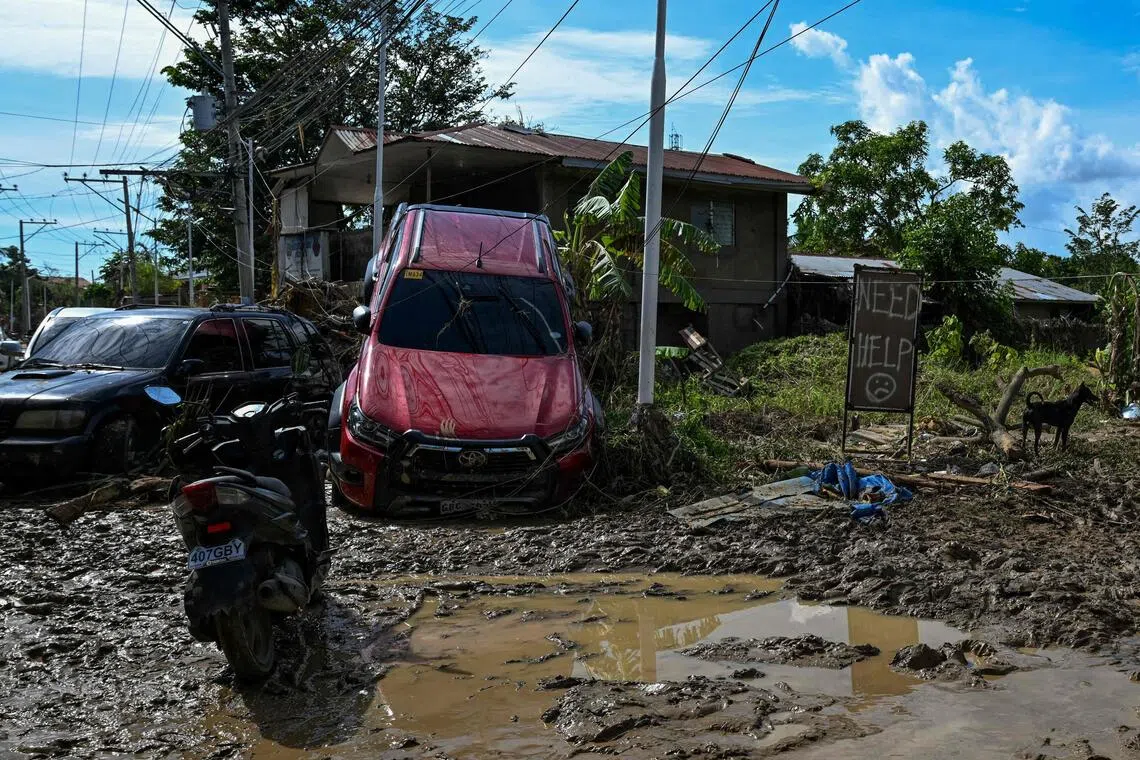Philippine death toll tops 140 as Typhoon Kalmaegi heads towards Vietnam
Sign up now: Get insights on Asia's fast-moving developments

Cars piled up on Nov 6 in the aftermath of Typhoon Kalmaegi in Liloan, a town near Cebu city.
PHOTO: AFP
Follow topic:
LILOAN, Philippines – Typhoon Kalmaegi has killed at least 140 people and left another 127 missing after unleashing devastating flooding across the central Philippines, official figures showed on Nov 6, as the storm headed towards Vietnam.
The typhoon is so far the globe’s deadliest of 2025, according to disaster database EM-DAT.
Typhoon Trami, also in the Philippines, was 2024’s third-deadliest typhoon with 191 fatalities.
Flood waters described as unprecedented rushed through Cebu province’s towns and cities this week, sweeping away cars, riverside shanties and even massive shipping containers.
The national civil defence office on Nov 6 confirmed 114 deaths, though that tally did not include an additional 28 recorded by the Cebu provincial authorities.
In Liloan, a town near Cebu City where 35 bodies have been recovered, AFP reporters saw cars piled atop one another by flood waters and roofs torn off buildings as residents attempted to dig out of the mud.
Ms Christine Aton’s sister Michelle, who has a disability, was among Liloan’s victims, trapped in her bedroom as the flood waters rose inside their house.
“We tried to prise open (her bedroom door) with a kitchen knife and a crowbar but it wouldn’t budge... Then the refrigerator started to float,” Ms Aton, 29, said.
“I opened a window and my father and I swam out. We were crying because we wanted to save my older sister.
“But my father told me we couldn’t do anything for her, that all three of us might end up dead.”
Mr Chyros Roa, a 42-year-old father of two, said his family was saved by his dog’s barking when water rushed into their home in the early hours, giving them just enough time to reach their roof.
“The current was really strong. We tried to call for rescue but no one came. We were told the rescuers were swept away by the current,” he said.
On Nov 6, President Ferdinand Marcos Jr declared a “state of national calamity”, authorising the government to release funding for aid and impose price ceilings on basic necessities.
‘Once every 20 years’
State weather service meteorologist Benison Estareja told AFP that the rains along Kalmaegi’s path were 1½ times the amount that would typically fall in Cebu for a full November, saying it was something that happened “once every 20 years”.
The “highly urbanised” nature of the most-affected communities around Cebu City had made them even deadlier, he added.
On Nov 5, residents busily cleaning up streets that had been rivers less than 24 hours earlier told AFP that they could remember nothing like it.
“Around four or five in the morning, the water was so strong that you couldn’t even step outside,” said Mr Reynaldo Vergara, 53, adding that everything in his small shop in Mandaue was lost when a nearby river overflowed.
“Nothing like this has ever happened. The water was raging.”
In a radio interview, provincial governor Pamela Baricuatro called the situation “unprecedented”.
Scientists warn that storms are becoming more powerful due to human-driven climate change.
Warmer oceans allow typhoons to strengthen rapidly, and a warmer atmosphere holds more moisture, meaning heavier rainfall.
Kalmaegi’s wind speeds were increasing on Nov 6 as it headed towards neighbouring Vietnam, where fear was mounting that the typhoon could compound the damage from a week of flooding that has already claimed 47 lives.
The typhoon was forecast to make landfall in central Vietnam late on Nov 6, bringing waves as high as 8m and powerful storm surges, according to the national weather bureau.
Deputy Prime Minister Tran Hong Ha urged the local authorities to treat Kalmaegi as “urgent and dangerous”, calling it “a very abnormal” storm in a statement on Nov 5.
The authorities have ordered thousands to evacuate from coastal communities, and in Quy Nhon city – just south of where Kalmaegi is forecast to make landfall – an AFP reporter saw officials knocking on doors on Nov 6 warning people to flee.
Ten typhoons or tropical storms usually affect Vietnam, directly or offshore, in a given year, but Typhoon Kalmaegi is set to be the 13th of 2025.
The Philippines has already reached its average of 20 such storms with Kalmaegi, state weather specialist Charmagne Varilla said, adding that at least “three to five more” storms could be expected by December’s end.
The 21st storm is already on its way, according to the state weather service.
More than 1,500km to the country’s east, Tropical Storm Fung-wong is slowly building strength as it heads towards the Philippine’s main island of Luzon.
It could reach super typhoon status before it makes landfall on Nov 10. AFP

